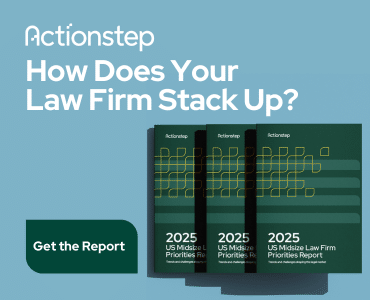Keeping underperforming billers on your team may feel like giving second chances, but really, it’s just an expensive act of complacency. Let’s do the math.

Table of contents
Underperformers cost your firm far more than their salary. They create a drag on revenue, waste valuable leadership time and poison your culture, eventually driving away the very people you can’t afford to lose.
The Real Costs of Underperforming Billers
In most law firms, the standard expectation is that a billable employee generates at least three times their salary in revenue. It’s the basic rule of thirds. One-third of their billables goes to pay their salary. Another third covers the firm’s overhead. The final third is profit — the part that allows you to reinvest in growth, reward top people, build a sustainable business, and pay yourself for the time, effort and risk you put into owning the firm. When someone doesn’t hit their numbers that third bucket, your profit, is always the first to vanish. It’s you and your family that take the hit.
Read: Understanding Law Firm Profits — And What to Do With Them
Let’s do the hard math.
Say you have an associate making $150,000. They should collect at least $450,000, but they only bill and collect $300,000. They barely covered their fair share of overhead, and your profit is gutted. Keep them for a year, and you’ve lost at least $150,000. But that cash is only the beginning.
Now layer in the distraction cost. Underperformers come with baggage. You and your leadership team spend hours reminding them to enter their time, checking their progress, scheduling meetings to diagnose why they’re falling short, and trying to coach them into doing the job they were hired to do. Every one of those hours is time you’re not spending with your high performers, developing business, billing or solving real problems.
Add in their mentor, their supervising partner and your HR team, and you’re looking at maybe 30 to 40 hours a month of pure distraction. It’s a hidden tax you pay month after month.
Read: The Best Compensation Plans Use the Law of Thirds
The high cost of cultural corrosion.
And then there’s the cost that doesn’t show up on the P&L: the cultural corrosion. Your team notices who’s pulling their weight and who isn’t. Gossip starts around the proverbial watercooler. “Did you see that X didn’t hit their numbers again?” “Why do they get special treatment?” “Why am I busting my ass while they coast?” These are the whispers that grow louder with time.
Eventually, your best people start to question whether this is the kind of place where they want to build a career.
When your stars leave, it’s not just disappointing, it’s devastating. Replacing a top performer typically costs at least 50% of their salary in recruiting costs.
Worse, you lose one to two times their salary in missed billables while you try to find and ramp up someone new. And that’s if you can find the right person quickly. And we all know how hard it is to hire right now. That underperformer didn’t just cost you in their own numbers; they chased away your top line.
Read: The Real Cost of Employee Turnover
So, what should you do about underperforming billers?
Get Clear, Get Honest and Take Action
Start with clarity.
The Entrepreneurial Operating System (EOS) uses the “GWC” tool to evaluate whether someone is the right fit for the role. GWC stands for “Get It, Want It, and Capacity to Do It.”
- Get It: Do they truly understand what the job requires?
- Want It: Do they genuinely want to do it?
- Capacity: Do they have the mental, emotional and technical capacity to perform at the level required?
If the answer to even one of these three questions is no, they’re not in the right seat, and they may not be on the right bus. They have to go, and it’s not up for debate.
Once you’ve identified a mismatch, act.
No underperformer should linger on your payroll for more than five months. Start with a review and give them clear, measurable targets. When their next review rolls around in three months, you should see marked improvement. If not, it’s time for a performance improvement plan. This process should be professional and structured, but also firm. Regular check-ins with targets and the understanding that if you “don’t see immediate and consistent improvement, action, up to and including termination may result.”
If done correctly, most underperformers will self-select out before you have to make that final call.
Don’t fall into the trap of thinking you’re doing anyone a favor by keeping them longer.
The longer an underperformer stays, the more damage they do. They erode your culture, normalize mediocrity, and start pulling others down with them.
Underperformers often recruit other borderline employees to adopt their mindset and behavior. That slow cultural rot is far harder and more expensive to fix than one tough personnel decision.
Here’s the kicker. Underperformers generally aren’t happy. They know they are underperforming. They spend time avoiding you, their supervisors, and the work that they can’t or don’t want to do. Letting them go so they can find a place where they are a better fit and can really shine is the kinder action.
Complacency About Underperforming Billers Is Costly
It eats your profit, hijacks your time and drives away your best people. So get clear, get honest and take action. Your stars are watching. And they expect leadership that protects their performance environment, not one that lets it get dragged down by the lowest common denominator.
More Profitable Law Firm Tips from Brooke Lively
For more tips on building a more profitable law firm, read:
- What Should Be on Your Law Firm’s Dashboard
- Are Your Law Firm’s Financial Systems Ready to Scale?
- The Path to Partnership: Embracing the ‘P’ Word Is the Key to Law Firm Growth
- Law Firm Profits and Year-End Taxes: Avoiding a Surprise Tax Bill
- 5 Ways You May Be Sabotaging Your Firm’s Growth
- The Best Compensation Plans Use the Law of Thirds
- Law Firm Overhead: What It Is — and What It Isn’t
- Building a Law Firm That Pays You First
- Understanding Law Firm Profits — And What to Do With Them
- How Are Law Firm Owners Paid? Total Compensation vs. Salary
- Funding Growth: Are You Starving Your Law Firm?
Image © iStockPhoto.com.

Sign up for Attorney at Work’s daily practice tips newsletter here and subscribe to our podcast, Attorney at Work Today.
















